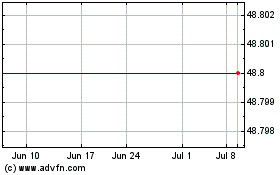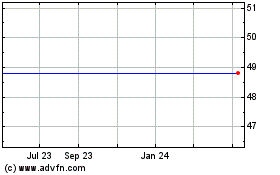American Electric Power, FirstEnergy Get Ohio Approval to Shift Some Cost Burdens to Customers
March 31 2016 - 5:42PM
Dow Jones News
By Cassandra Sweet
Two of the nation's largest electricity producers, American
Electric Power Co., Inc. and FirstEnergy Corp., on Thursday won
regulatory approval in their home state of Ohio to shift the
financial burden of unprofitable power plants to consumers.
The Public Utilities Commission of Ohio voted unanimously to
approve plans to have consumers pay extra to keep the plants
running, over objections from rival power-plant owners and consumer
groups, who said the moves would raise utility bills and hurt
competition.
"The electricity industry as a whole is in a period of
transition," commission chairman Andre Porter said. "Ohioans should
not be alarmed by the transition."
Under the plans, FirstEnergy, based in Akron, and AEP, based in
Columbus, would have their regulated Ohio utilities buy power from
seven old coal-fired plants and one nuclear plant owned by their
unregulated businesses. The utilities will then sell that
electricity on the wholesale market.
Because there is a surplus of electricity in the region and
prices are at historically low levels, the companies argued that
they won't generate enough money from ordinary electricity sales to
keep the plants running.
So to keep the facilities operating, Ohio regulators agreed to
allow the companies to charge utility customers for the shortfall
between what the companies say it costs to produce the power and
what they can fetch on the wholesale market. The arrangements run
from this coming June to May 2024.
"We're pleased that the commission has made a decision on our
proposal, following a thorough analysis of our plan," FirstEnergy
spokesman Doug Colafella said.
AEP's plan will benefit consumers, support the state's economy
and preserve jobs, the company's chief executive Nicholas Akins
said.
FirstEnergy and AEP have argued that while the utilities may
lose money on the deals now, customers will get money back on their
bills if wholesale prices rise in the future and the power sales
make money.
Under the plans, if utilities can later fetch certain higher
prices on the wholesale market, they would pass some of the profit
on to customers in the form of rebates.
Rival power plant owners such as Dynegy Inc. and Exelon Corp.,
however, opposed the plans. "This is a clear example of state
intervention that hurts competition, hurts prices and hurts
citizens," Dynegy Chief Executive Bob Flexon said.
Mr. Flexon said Dynegy, which owns several Ohio power plants,
including some it co-owns with AEP, could provide Ohioans the same
power for much less money. He said Dynegy would continue fighting
the plans through state and federal regulators and in court, if
necessary.
A coalition of power companies, including Dynegy, has filed
complaints with federal regulators to block AEP's and FirstEnergy's
plans. The matter is pending before the Federal Energy Regulatory
Commission.
PJM Interconnection, the organization overseeing the PJM
wholesale power market that includes Ohio and 12 other Midwestern,
mid-Atlantic and East Coast states, has joined in opposition to
AEP's and FirstEnergy's plans, arguing they violate competitive
wholesale market rules.
Average wholesale power prices in Ohio and elsewhere in the PJM
market have fallen by one-half since 2014 to $31.27 a megawatt-hour
this year to date, according to a Wall Street Journal analysis of
market data compiled by the Energy Department.
Consumer and environmental groups also oppose the plans, saying
they are a bad deal for consumers and the environment. "These
bailouts subsidize old power plants that are dirtying our air. It's
a terrible deal for Ohioans' health and wallets," said Jim Marston,
a vice president at the Environmental Defense Fund. The
organization has said it plans to continue fighting the companies'
plans and would be prepared to sue in court.
Write to Cassandra Sweet at cassandra.sweet@wsj.com
(END) Dow Jones Newswires
March 31, 2016 17:27 ET (21:27 GMT)
Copyright (c) 2016 Dow Jones & Company, Inc.
Exelon (NYSE:EXC)
Historical Stock Chart
From Mar 2024 to Apr 2024

Exelon (NYSE:EXC)
Historical Stock Chart
From Apr 2023 to Apr 2024
